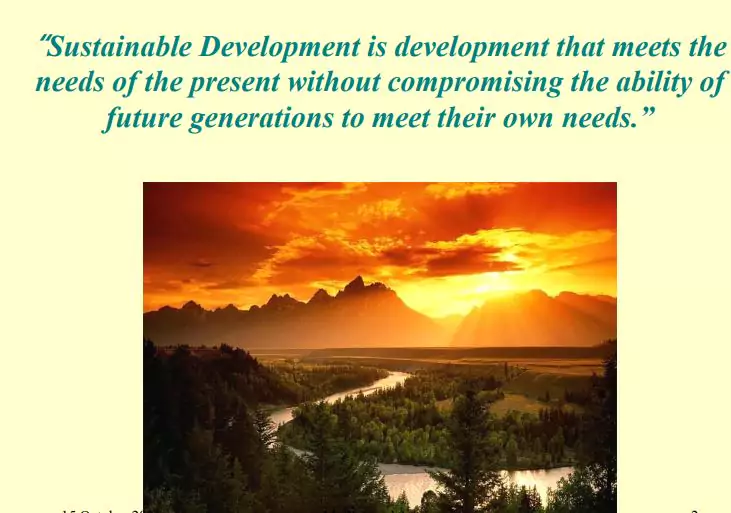‘Project on Sustainable Development For Class 10’ PDF Quick download link is given at the bottom of this article. You can see the PDF demo, size of the PDF, page numbers, and direct download Free PDF of ‘Sustainable Development Environmental Solutions’ using the download button.
Project On Sustainable Development PDF Free Download

The Concept of Sustainable Development
The concept of ‘Sustainable Development’ was formulated in 1987 by the World Commission on Environment and Development, popularly known as the Brundtland Commission.
It was established by the United Nations General Assembly in 1983.
In the eighties of the 20th century, world leaders became acutely aware that the environment was fast deteriorating due to the over-exploitation of nature by human beings.
his ‘Chairman’s Foreword’ Gro Harlem Brundtland observed The present decade [the eighties] has been marked by a retreat from social concerns.
Scientists bring to our attention urgent and compelling problems of survival: a warming globe, threats to the Earth’s ozone layer, deserts consuming agricultural land.
The report entitled Our Common Future (United Nations, 1987) makes a scathing criticism of ur social and political practices which had negatively impacted on planet Earth.
Some of these are as follows:
• Infant mortality is declining. Human life expectancy is increasing. But the number of hungry people in the world is increasing. (Art 5&6).
• Increase in desertification, widespread destruction of forests, acid rain, burning of fossil fuel causing global warming (Art.7).
A major cause and effect of global environmental problems is poverty (Art.8).
• The arms race has led to a rise in global military expenditures (Art.20).
The Brundtland report concluded that there was growing realization among national overnments and multilateral institutions that ‘it is impossible to separate economic developmental issues from environmental issues; many forms of development erode the environmental resources upon hich they must be based, and environmental degradation canundermine economic development.
The Brundtland Commission had three objectives:
1) to re-examine the environment and evelopment issues and formulate a ‘realistic proposal’ to solve these issues ;
2) propose newforms and co-operation on these issues; 3) to ‘raise the level of understanding and commitmentof a wide spectrum of people, businesses, governments voluntary organizations, and institutes.
The concept of ‘Sustainable Development’ emerged from the deliberations of the Brundtland
Commission.
The Commission defined ‘Sustainable Development’ as to ‘meet the needs of thepresent without compromising the ability of future generations to meet their own needs’
Among the recommendations made by the Commission are a) limit population growth)ensure food security ; c) ensure safe energy; d) control export of hazardous industrialchemicals; good city management ;(Art 40-74) e) there is the grave threat of nuclear war ; toachieve peace and security , there is need to improve relations among major powers (Art.88).
Sustainable Development Goals Based on the recommendations of the Brundtland Commission, the United Nations adopted 17 Sustainable Development Goals (SDG) in 2015(Fig. 1).
Among these goals, the first twelve and the last two (16 and 17) may be regarded as human development goals.
Goals no.13, 14and 15 may be regarded as environmental protection goals.
The United Nations observes that sustainable Development in India: A Review of the LiteratureLet us first examine the literature on Sustainable Development in India.
Here we will examine the major trends in research as well as government policies related to SDGs.
A Google searchon the topic ‘Sustainable Development in India’ on 25-01-2022 at 9.03 am found 30,20,000 results.
Part A. Human Development.
Poverty AlleviationThe first SDG is No poverty.
The ‘2020 Global Multidimensional Poverty Index’ presents agrim picture of poverty across the world.
Among 107 developing countries, 1.3 billion or 22percent live in multidimensional poverty. About 84.3% of the multidimensionally poor peoplelive in sub-Saharan Africa (558 million) and South Asia (530 million).
Of them, 1.3 billion suffer simultaneous deprivation in at least 5 SDG indicators simultaneously. (United NationsDevelopment Programme, 2020).
Niti Ayog published a baseline report on poverty. (Niti Ayog, 2015)According to Niti Ayog’sPoverty Index, Bihar, Jharkhand and Uttar Pradesh are thepoorest states in India.
By contrast, Kerala, Goa and Sikkim are least poor and so they areplaced at the bottom of the index. (Press Trust of India , 2021).
The Government of India’sEconomic Survey (2017) admitted that rural poverty is high. (OECD, 2017)
A ‘Google Scholar’ search on ‘Poverty alleviation and Sustainable Development in India’ inthe afternoon of 8th February, 2022, unearthed 1,89,000 results.
A summary of the researchesreveal some significant trends .
1) Poverty has been reducedthanks to pro poor policies of thegovernment . (Datt, 2016)2) Unsustainability and poverty are interlinked.
2)Projects such as Clean Development Mechanisms have not contributed to the alleviation of rural poverty. (Sirohi, 2007) From these studies we may conclude that poverty is still a grim social fact in India.
Alleviation of poverty must go hand in hand with sustainable development.
But researchers focused on rural poverty. What about urban poverty?
| Author | Md. Shamsul Arefin |
| Language | English |
| No. of Pages | 22 |
| PDF Size | 2 MB |
| Category | Education |
| Source/Credits | pdffile.co.in |
Project On Sustainable Development PDF Free Download
